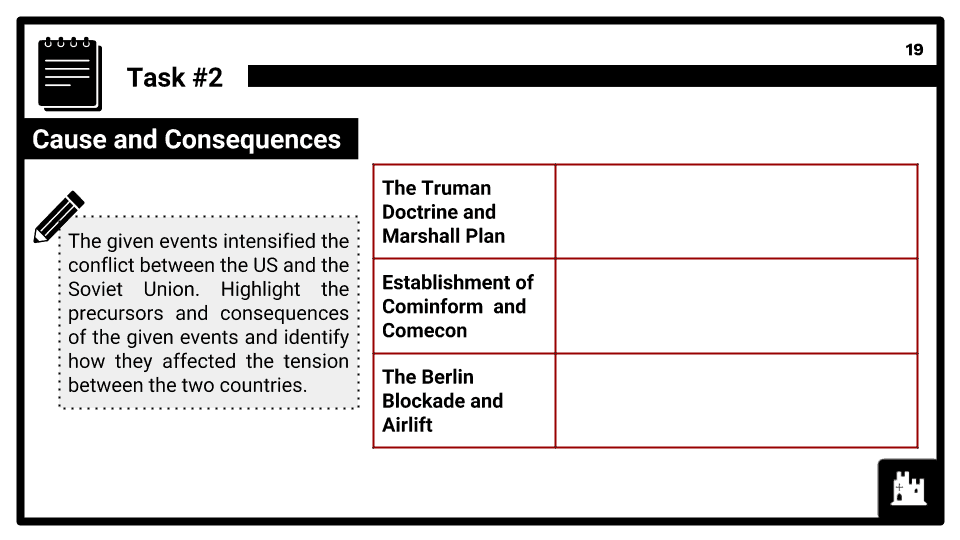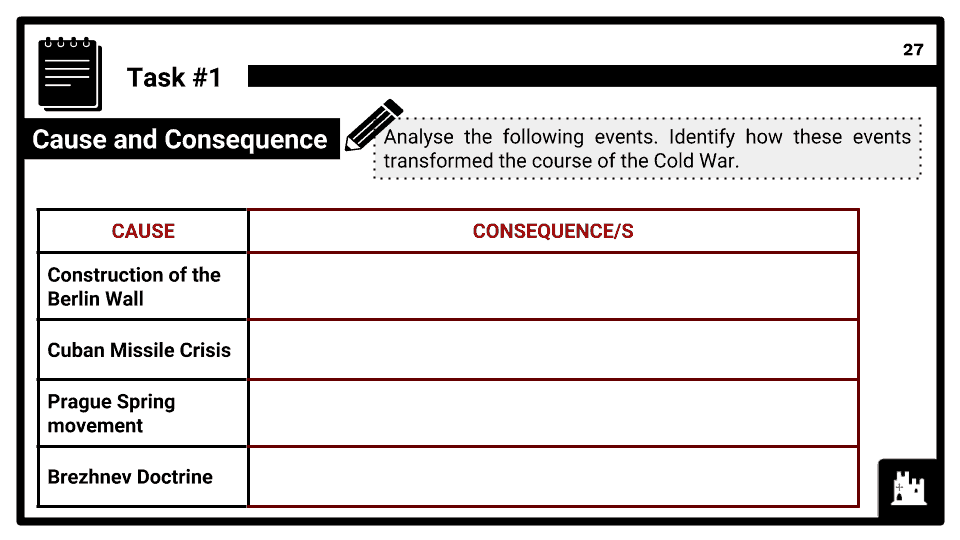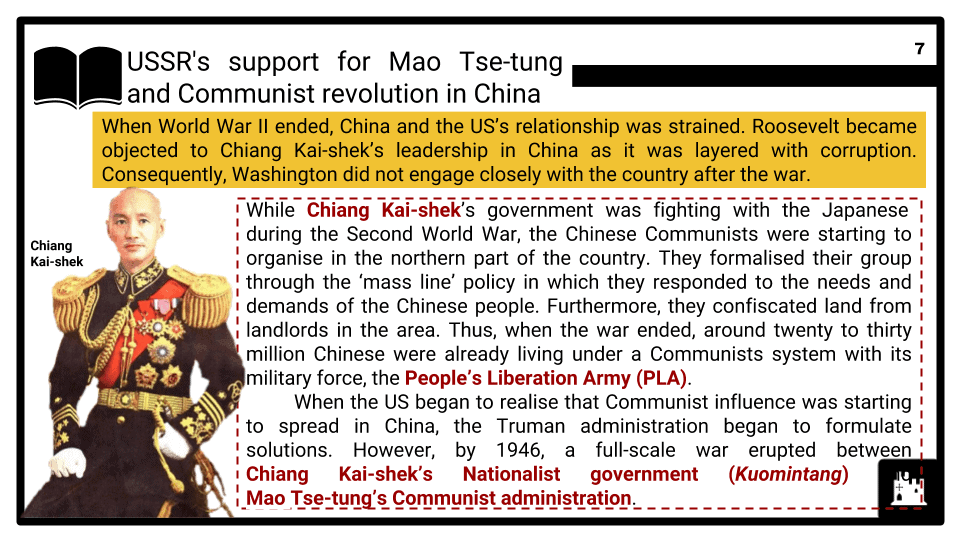Teach any AQA module BC Conflict and Tension between East and West, 1945-1972, no prep needed!
Do you want to save dozens of hours in time? Get your evenings and weekends back? Be fully prepared to teach any AQA GCSE topic?
Every AQA topic is covered, and each module comes complete with:
BC Conflict and Tension between East and West, 1945-1972
In this module, the focus is on the tense relationship between the US and USSR superpowers in the decades after the Second World War. This wider world depth study enables students to understand the complex and diverse interests of the Great Powers and other states. It focuses on the causes, nature and conclusion of the First World War and seeks to show how and why conflict occurred, and why it proved difficult to bring the war to a conclusion. This study also considers the role of key individuals and groups in shaping change and how they were affected by and influenced international relations.
Students will study the political, economic and ideological aspects of the conflict between the US and the USSR as well as the influence of various leaders of the powers throughout the decades. This module consists of three parts detailed below:
Part one: The origins of the Cold War
Themes explored include:
- The end of the Second World War: Yalta and Potsdam Conferences; the division of Germany; contrasting attitudes and ideologies of the USA and the USSR, including the aims of Stalin, Churchill, Roosevelt, Attlee and Truman; the effect of the dropping of the atom bomb on post-war superpower relations.
- The Iron Curtain and the evolution of East-West rivalry: Soviet expansion in East Europe; US policies; the Truman Doctrine and Marshall Plan, their purpose and Stalin’s reaction; Cominform; Comecon; Yugoslavia; the Berlin Blockade and Airlift.
Part two: The development of the Cold War
Themes explored include:
- The significance of events in Asia for superpower relations: USSR's support for Mao Tse-tung and Communist revolution in China, and the military campaigns waged by North Korea against the UN and by the Vietcong against France and the USA.
- Military rivalries: the arms race; membership and purposes of NATO and the Warsaw Pact; the space race, including Sputnik, ICBMs, Polaris, Gagarin, Apollo.
- The ‘Thaw’: Hungary, the protest movement and the reforms of Nagy; Soviet fears, how they reacted and the effects on the Cold War; the U2 Crisis and its effects on the Paris Peace Summit and the peace process.
Part three: Transformation of the Cold War
Themes explored include:
- The Berlin Wall: reasons for its construction and Kennedy’s response.
- Tensions over Cuba: Castro’s revolution, the Bay of Pigs and the missile crisis: the roles of Castro, Khrushchev, Kennedy; fears of the USA and reaction to missiles on Cuba; dangers and results of crisis.
- Czechoslovakia: Dubeck and the Prague Spring movement; USSR’s response to the reforms; the effects the Prague Spring had on East-West relations, including the Warsaw Pact; the Brezhnev Doctrine.
- Easing of tension: sources of tension, including the Soviets' record on human rights; the reasons for Détente and for SALT 1; the part played by key individuals Brezhnev and Nixon.
This module download also includes the following teaching resources:
- Module 6 Gorbachev Information (pptx)
- Module 6 Gorbachev Information (pdf)
- Module 6 Prague Spring Information Sheet (pptx)
- Module 6 Solidarity (pptx)
- Module 6 Solidarity Movement Poland 1989 (mp4)
- Module 6 Prague Spring Information Sheet (pdf)
- L9 Group Packs (pptx)
- L7 Source Pictures For Students (pptx)
- L7 Source Pictures For Students (pdf)
- Module 5 How Effectively Did The Usa Contain The Spread Of Communism (docx)
- Module 6 Brezhnev Doctrine (pdf)
- Module 6 Brezhnev Doctrine (pptx)
- Module 6 What Was The Prague Spring- (mp4)
- L7 Source Information For Students (pptx)
- L5 Berlin Airlift Fact File (pdf)
- L13 John F (mp4)
- Module 6 Czechoslovakia 1968 (pptx)
- Module 6 Gorbachev And The End Of The Cold War (pptx)
- Module 5 The History Of The Cuban Missile Crisis Matthew A (mp4)
- L9 Group Packs (pdf)
- L4 Truman Doctrine And Marshall Plan Information Sheet (pptx)
- L6 The Berlin Blockade 10m (mp4)
- Module 5 How Effectively Did The Usa Contain The Spread Of Communism (pdf)
- L8 The Arms Race (pdf)
- L5 Cominform And Comecon Information Sheet (pdf)
- L8 The Arms Race (doc)
- L2 Difference Between Nations Statements (pptx)
- L7 Source Information For Students (pdf)
- L5 Berlin Airlift Fact File (docx)
- L13 Berlin Wall (pptx)
- L2 Difference Between Nations Statements (pdf)
- L3 Timeline Information (pdf)
- L4 Truman Doctrine And Marshall Plan Information Sheet (pdf)
- Module 5 Cuban Missile Crisis (pptx)
- L9 Hungarian Uprising (pptx)
- L4 Truman Doctrine And Marshall Plan (pptx)
- L3 Us-Soviet Relations (pptx)
- L5 Cominform And Comecon (pptx)
- L7 Warsaw Pact (pptx)
- L2 Ideological Differences Worksheet Low Ability Sheet (pdf)
- L4 Student Fill In Sheet Truman Doctrine Marshall Plan And Soviet Response (pdf)
- L6 Berlin Crisis (pptx)
- L3 Timeline Information (pptx)
- L2 Ideological Differences (pptx)
- L1 Tehran Yalta And Potsdam Conferences (pptx)
- AQA GCSE History Exam Booklets (2020 & 2021 Syllabus) (zip)




